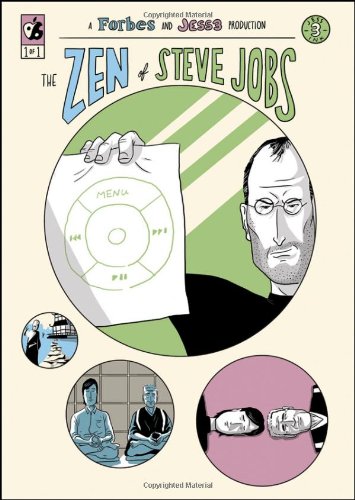
The Zen of Steve Jobs
کتاب های مرتبط
- اطلاعات
- نقد و بررسی
- دیدگاه کاربران
نقد و بررسی

February 13, 2012
At one point in this graphic novel biography, the titular icon states his design philosophy in a succinct phrase: “What you leave out will shape the whole.” This also describes the philosophy driving this book. While not a conventional biography, this book uses a nonlinear mosaic structure to give the reader glimpses into Jobs’s relationship with Zen roshi Kobun Chino Otogawa, whom he met following his ouster from Apple. Melby starts with the near collapse of Apple Computers in 1985 and then jumps around a time line that covers decades. Each scene connects loosely to the next, sometimes showing the origins of ideas Jobs would later employ in redesigning Mac, sometimes connecting only through the relationship between the priest and his student. Melby portrays Jobs as an aggressive egotist as much as an innovator, and particularly later in the book, he is shown to be careless with his friends. The artwork uses shadow and color to indicate form in a way that is deliberately reminiscent of early iPod commercials. A fascinating section in the back matter details the artists’ process in finding that aesthetic. Overall, the drawings and the sparseness of the narrative work together to shape a fine story, one perhaps too large to be told in one volume.

March 15, 2012
This innovative graphic novel unveils a less publicized part of Jobs: his flirtation with Zen Buddhism and friendship with Kobun Chino Otogawa, as iconoclastic a Zen priest as Jobs was a computer guru--and how Jobs' tinge of Zenitude affected Apple products. Drawing on extensive research, Melby reimagines their relationship as a push-pull between action and letting go, between substance and space, between perfection and mistakes. The final image depicts Jobs crowing "Perfect" at his own calligraphy of the kanji character for "mistake." Kobun's final mistake was attending to meditation rather than to his young daughter, which led to their joint drowning. The art is fluid, two-color washes, abetted by insightful extras that supply context. VERDICT Drawing on two famous figures, Melby raises many of the Important Questions: how to live one's life? What is substance and what is background, and how can they dance together? What will be left as legacy? An intriguing readalike for teen and adult readers of Isaacson's bestselling Jobs biography plus other geeks and geek-curious.--M.C.
Copyright 2012 Library Journal, LLC Used with permission.

























دیدگاه کاربران